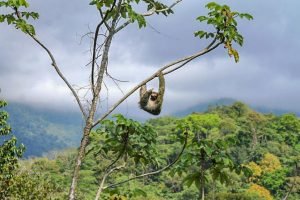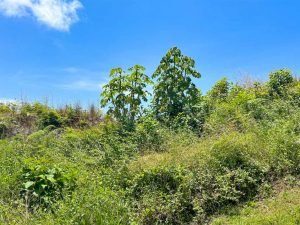Cecropia Tree & its Delicious Fruit

This common tree, considered by many to be a ‘just a weed’, is actually a fascinating plant favored by scores of animals such as monkeys, macaws, sloths and toucans – plus it has a very strange symbiotic relationship with Azteca ants, is great at holding back eroding slopes or reforesting cleared areas, and bears a weird fruit that is rarely eaten but in fact considered a sweet treat and a succulent delicacy by man and animal alike. There so much more to this tree than its (well-deserved) reputation as a fast growing weed – read on!


🌳 PIONEER SPECIES
We have all seen Cecropias, known as Guarumo in Costa Rica – the tall and lanky trees with very few branches, see-through upper canopies and giant mufti-lobed umbrella-like leaves. They are very noticeable because of their status of ‘pioneer species’ – meaning these trees are among the first large plants to spring up on land that has been cleared by a bulldozer, landslide, flooding, hurricane or fire.
If a giant tree falls in the rainforest, it will be the Cecropias that fill in the gap to steal the sunshine. They aggressively outgrow and outcompete all other plants as they race upwards – growing in rich soil, poor soil, sand, or gravel and rocks. Their succulent fruit are favored by many species, and because a single tree can produce 1,000,000 seeds per season, you can imagine how far and wide the seeds are dispersed by hungry animals. So Cecropias have become a very common sight in tropical areas where they proudly and unscrupulously plant themselves wherever they please.
In many areas of tropics and subtropics Cecropias are intentionally planted to re-forest land or as an emergency anti-erosion measure to stabilize slopes and riverbanks. They retain the soil and create new biomass which will then allow other plants to move in. Cecropias grow rapidly to reach a height of 20m or more, with roots that tend to spread out and hold the soil, a perfect choice for soil stabilization; however they live fast and die fast – a typical lifespan of a Cecropia tree is less than 20 years.


🌳 THE WEIRD & TASTY FRUIT
An Unknown Delicacy
The Cecropia fruit, known as Snake Fingers, Ambaiba, Trumpet Tree Fruit, or Gummy Bear Fruit (amongst many others) is considered an exotic delicacy. The fruit are sweet, tasty, aromatic, juicy, savory and with a jelly-like consistency – thus the ‘Gummy Bear’ reference. They are very high in Vitamins A, Bs, C, and calcium and potassium, as well as antioxidants. The fruit can be eaten raw but it is very common to dry them for later consumption or to use them in the making of jams and marmalades. Owing to their juicy nature, the fruit are rather perishable and should be dried, refrigerated, eaten or made into smoothies or jam with minimal delay following harvest or purchase.
Fruit & Flowers
Each flower produces between 1-4 long slender fruit, 10-15 cm in length and 1-2 cm in diameter. When young and unripe, as in the first photo below, the fruit point up. As the mature, they drop and hang down, as seen in the second photo. In tropical settings fruit are produced year-round.


🌳 ANIMALS LOVE THE CECROPIA
The sweet, juicy fruit draws a wide range of wildlife with ease. Monkeys, toucans, parrots, macaws, fruit bats, aracaris, possums, and even fish eagerly feed on it. Birds of countless varieties flock to the tree and carry its tiny seeds across vast distances. Animals rely on the Gummy Bear Fruit as a keystone food source, especially in areas where Cecropia trees grow in great numbers and cover wide ranges.
Sloths adore the Cecropia and often lounge in its branches. The sparse canopy makes them easy to spot, standing out against the open sky. They munch on the large leaves, sometimes lingering for hours without moving. One leaf often keeps a sloth occupied long enough to match its famously slow pace. The tree offers both shelter and snacks, making it a favorite hangout for these laid-back creatures.

A Howler Monkey in a Cecropia tree.


🌳 A SYMBIOTIC RELATIONSHIP WITH ANTS
A unique relationship has been formed between the Cecropia tree and Azteca ants. Shelter and nesting space are provided to the ants through hollow stem chambers. Sweet liquid food bodies, grown at the base of Cecropia leaves, are consumed as a high-energy resource. In exchange, protection is offered to the tree by the ants. Leaf-cutting ant species are repelled, and invasive vines are aggressively attacked before they can overtake the host.
As a pioneer species, Cecropia is often targeted by vines seeking a shortcut to sunlight. Serious harm can be caused to the tree by these vines, and easier access is granted to pests. Any climbing plant is chewed through by the Azteca without hesitation. Constant patrols are maintained along the stem and leaves by the ants. Herbivorous insects are attacked on contact, and painful bites are delivered to larger animals such as sloths and monkeys.
Communication is initiated by the Cecropia when danger is sensed. Distress chemicals are released from damaged leaves to alert the ants. A rapid response is triggered, and dozens of ants emerge from the hollow stem. The damaged leaf is reached quickly, and a frantic search for the intruder is carried out.
One final amazing fact. Fine hairs cover the Cecropia’s surface and interact with hooks on the ants’ legs. Secure anchoring is enabled, giving the ants leverage during fights with larger invasive insects.
🌳 AN INVASIVE ALIEN
One specie of Cecropia is considered to be one of the top 100 invasive alien species in the world. Cecropia peltata, which grows in our area, is wreaking havoc in Africa where it is displacing a very similar but not closely related tree known as Parasolier or African Corkwood Tree. The Parasolier is a very similar tree in looks and habits, also being a prolific pioneer specie, but it seems that Cecropia can outwit the outwitter.


🌳 USES OF CECROPIA TREE
ecropia wood is very similar to Balsa—extremely light and not especially strong, which is typical of fast-growing trees. Its softness makes it useful for matchsticks, cheap boxes, and lightweight lumber. It’s also used to craft musical instruments like guitars and flutes. One of its common names, “Trumpet Tree,” comes from its hollow branches. Indigenous peoples across its range have long used these branches to make wind instruments resembling flutes and trumpets.
The leaves of Cecropia are brewed into tea with several traditional uses. It is said to stimulate the heart and treat asthma and pneumonia. The tea is also used for diabetes and as a diuretic. In some regions, it helps treat snake bites. Powdered leaves are used to help manage Parkinson’s disease. These remedies reflect the plant’s role in folk medicine and its cultural significance.
Root extracts are said to help heal wounds and improve eczema.
Note that the mention of the above medical uses of Cecropia is not medical advice and you should always consult a Doctor before self-medicating or exploring natural or unverified medical treatments…especially if you have been bitten by a snake!
🌳 HOPE YOU WILL NEVER LOOK AT CECROPIA THE SAME WAY AGAIN!
Have I convinced you that the Cecropia tree is much more than ‘just a weed’? It is a plant that fascinates on multiple fronts – next time I see one, I will have a closer look as I attempt to spot the Azteca defenders, or perhaps I will give the tree a shake in hopes of scoring a bunch or two of the Gummy Bear Fruit!
Our tropical area boasts untold variety of strange, exotic, and tasty fruit – a visit to a local fruit stall will leave you speechless! Imagine living in a beautiful, tropical land where each day brings an explosion of new tastes and wonder – you can make this dream a reality much quicker than you think! Take the first step by browsing our local property listings here. RE/MAX WE SELL PARADISE is your trusted partner in this land of exotic and tropical culinary delights!
Photos #4,6,9,10 courtesy of Wikicommons.



